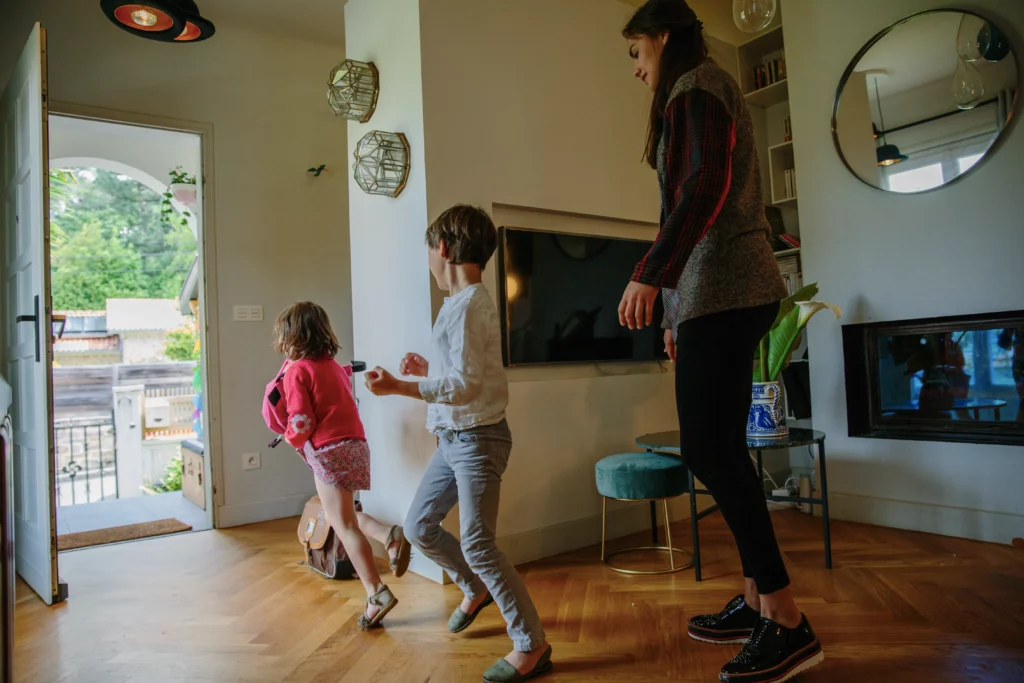The start of the new school year is always a busy time for parents, with all the logistics involved in looking after their children.
Whether your children are 6 months or 10 years old, you wonder how you’re going to manage the morning before you leave for work.
Not to mention in the evening, when you can’t always be there when they leave the crèche or school.
So we’d like to share with you the different individual childcare solutions available to you, depending on the age of your children (we’re not talking here about collective structures such as crèches or leisure centres).
1. The childcare solution for your young children: the childminder
Parents generally choose a childminder as an alternative to a crèche. A childminder is an early childhood professional. They look after children under the age of 6 on a full-time or after-school basis. She looks after between 2 and 4 children at any one time, usually in her own home, and each family draws up a contract with her.
The advantages of a childminder: a pedagogical framework, a person trained and approved by the PMI, a defined timetable and contract, several children, but not too many, which allows initial socialisation.
The disadvantages of a childminder: fixed hours (not very flexible if you have overflowing meetings), cumbersome administrative procedures.
2. The big-city alternative: the live-in nanny
In some large towns where there are not enough places in crèches or with childminders, another option is to hire a live-in nanny.
The nanny does not necessarily have to be a qualified childminder, but she does need to have experience of working with children. She looks after the children of one or 2 families (generally those under the age of 3) on a full-time basis in the parents’ home.
The advantages of a live-in nanny: flexible organisation, because parents don’t have to run to drop their child off or pick them up in the evening. Your child grows up in a familiar environment with someone dedicated to his or her well-being. This can be quite advantageous financially when you have at least 2 children.
The disadvantages of a live-in nanny: your home can quickly turn into a nursery (especially if you have shared childcare, which means you’ll need two sets of childcare equipment!
3. A babysitter for your schoolchildren
This is it! It’s here! Your children are finally off to school… so you’re about to discover the joys of organising after-school care.
The easiest solution is often the school nursery… but sometimes it closes too early for you to collect your child before 6pm. And then you tell yourself that it’s still a long day for your little ones.
A babysitter is the ideal solution if you only need a few hours a week (less than 15).
The advantage of a baby-sitter: a student baby-sitter is a dynamic person who can also do activities with your children or help them with their homework. They are generally flexible and can adjust if you arrive a little late in the evening. What’s more, you can sign an employment contract with the babysitter (either as a private employer or via an agency), which means you can claim a tax deduction.
The disadvantage of the baby-sitter: her university timetable can vary from one semester to the next, which can make it difficult to organise her on a permanent basis for the whole school year.
4. The au pair: combining flexibility and open-mindedness
The alternative to the baby-sitter is a solution that is relatively unknown in France, but very widespread in English-speaking countries.
An au pair is an ideal solution if you have siblings aged between 2 and 12. They are provided with accommodation, food and laundry and look after your children for 25 to 30 hours a week in exchange for pocket money (around 90 euros a week). This is pretty cheap when you have several children. As she lives with you, she quickly becomes a reference point, the big brother or sister who knows your children perfectly, which is more reassuring for them.
The advantages of an au pair: by living with you, you also have greater flexibility in terms of timetable, without having to count to the quarter of an hour and worry about arriving late because of traffic jams. Finally, it’s a great way to discover another culture.
The disadvantages of an au pair: You have to be prepared to live with a new person in your home who will be an integral part of the family.
5. Nounou ou jeune fille au pair : le témoignage d'Aurore
En général, les familles expérimentent plusieurs modes de garde avant de choisir celui qui leur convient le mieux. L’accueil d’une jeune fille au pair est une solution attrayante pour beaucoup de familles qui veulent aussi faire découvrir une langue étrangère à leurs enfants, mais le processus est long avant de se lancer !
C’est le cheminement qu’a connu Aurore, famille d’accueil maintenant depuis 6 ans et qui nous raconte pourquoi finalement elle a fait le choix d’accueillir une jeune fille au pair après diverses expériences.
6. Est-ce que le jeune au pair est un mode de garde adapté pour un bébé ?
C’est une question légitime.
La base du programme au pair est l’échange culturel. Les au pairs ont de l’expérience en garde d’enfants (baby-sittings, summer camps…) mais ne sont absolument pas des professionnels de la petite enfance. L’au pair n’est pas un mode de garde à proprement parlé pour un bébé. Elle s’occupera donc principalement de votre ainé tout en interagissant au quotidien avec votre bébé. Dans tous les cas, l’au pair ne peut être qu’une solution d’appoint (le matin ou en fin de journée), en complément d’un mode de garde professionnel comme une assistance maternelle ou la crèche.




